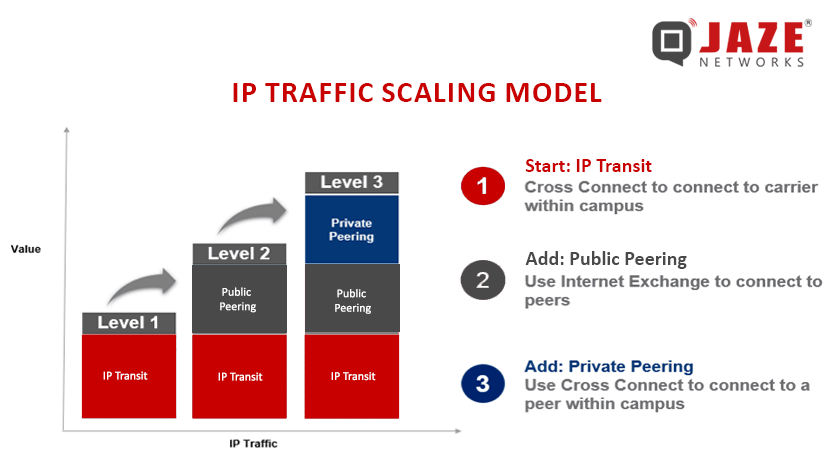As businesses scale and their internet traffic grows, understanding the intricacies of internet interconnection becomes crucial. Two key concepts in this domain are IP peering and IP transit. Though they may seem similar, they serve different purposes in optimizing an enterprise’s internet connectivity.
IP Peering: A Reciprocal Arrangement
IP peering is a mutual exchange of data between two internet service providers (ISPs). This arrangement is typically settlement-free, meaning neither party charges the other for the data exchanged. The primary advantage of IP peering is that it allows for direct data exchange, which can reduce latency and improve network performance. Peering can be public or private:
Public Peering: This occurs at an Internet Exchange Point (IXP), where multiple networks connect to exchange traffic. It leverages the Border Gateway Protocol (BGP) to efficiently route traffic through a single IXP.
Private Peering: This involves a dedicated connection between two networks, ideal for large volumes of traffic, offering greater control and performance compared to public peering.
However, peering requires careful management and negotiation, as each party must agree on the terms of the traffic exchange, including how much traffic is allowed and which routes are accessible.

IP Transit: Access to the Entire Internet
While peering is a direct relationship between two networks, IP transit is a commercial service where one network (the customer) pays another network (the provider) to deliver traffic to the rest of the internet. In essence, IP transit gives a network access to the global internet by leveraging the provider’s extensive network connections.
IP transit providers typically have large, well-connected networks with multiple peering and transit relationships, ensuring that their customers can reach any destination on the internet. The transit provider not only delivers the customer’s traffic to its final destination but also provides inbound access, allowing other networks to send traffic back to the customer.
IP transit is crucial for networks that require comprehensive internet access. Unlike peering, where traffic is exchanged only between two networks, IP transit covers the entire internet, making it essential for businesses that need to reach a global audience. This service is typically charged based on the volume of traffic sent and received, often measured in megabits per second (Mbps).
Key Differences
Cost Structure: IP peering is generally cost-effective as it is often settlement-free, whereas IP transit involves a recurring cost based on bandwidth usage.
Network Control: Peering provides more control over routing and can reduce dependency on third-party networks, while transit offers broader reach but less control.
Performance: Peering can enhance performance by reducing latency and potential points of failure, whereas transit ensures connectivity to a wider range of networks.
When to Use IP Peering
Enterprises might opt for IP peering when they have significant traffic with specific networks. For instance, if a company frequently exchanges data with another large network, peering can reduce costs and improve performance. Peering is also beneficial for content delivery networks (CDNs) and large-scale web services that require efficient and reliable data exchange.
When to Use IP Transit
IP transit is ideal for enterprises that need comprehensive internet access. It is particularly useful for smaller companies or those without the traffic volume to justify peering. Transit ensures that an enterprise can reach any part of the internet, making it a versatile solution for general internet connectivity.
When deciding between IP peering and IP transit, enterprises should consider their specific needs and traffic patterns. A hybrid approach, using both peering and transit, can often provide the best balance of cost, performance, and reliability. For example, an enterprise might use peering for high-volume traffic with specific networks and transit for broader internet access
ISPs can deliver bandwidth with lower latency and lower costs through peering with exchanges and content networks. This will greatly help in providing a better quality service and better end-user Internet experience. ISPs also need reliable OSS/BSS software to help deliver flexible Internet plans and manage business operations. Jaze ISP Manager in integration with BNG routers helps ISPs deliver service and manage operations. Click here for more information. Click here to learn more.






